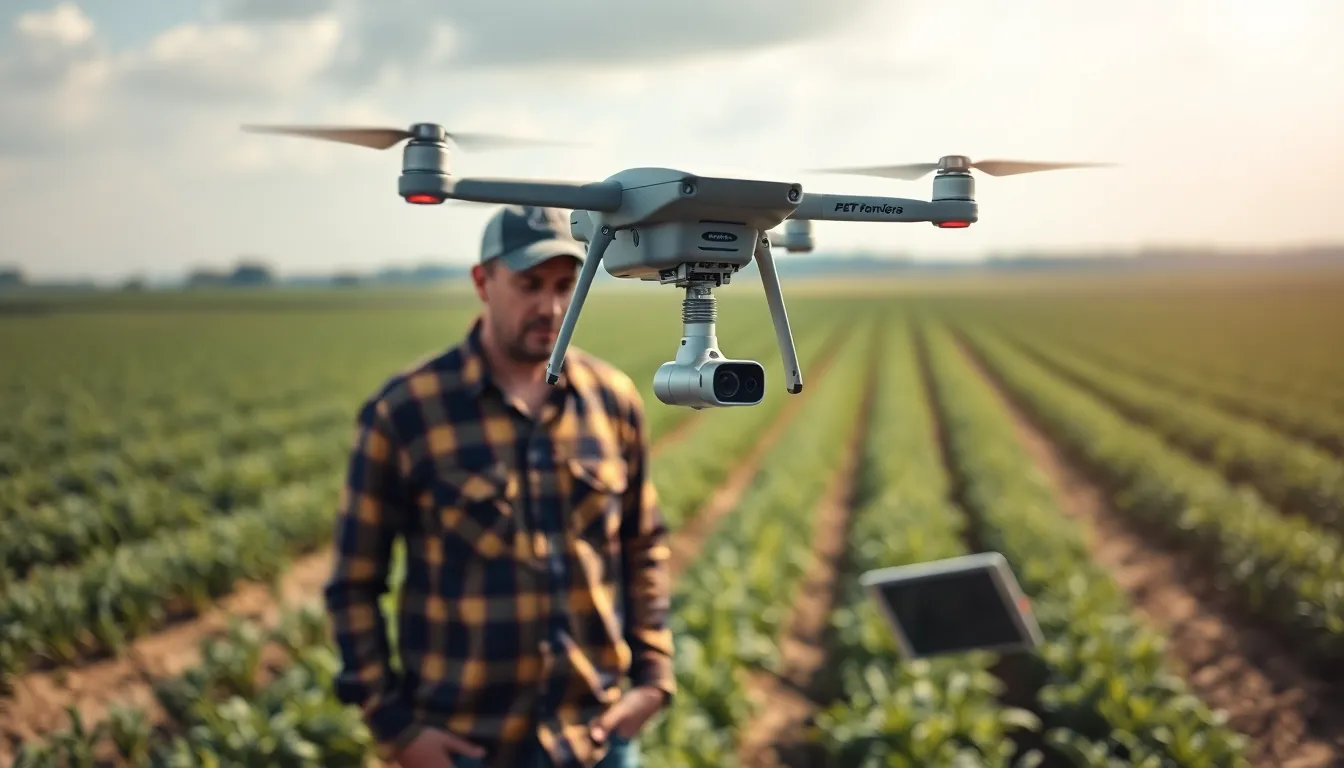In a world where technology zooms ahead faster than a drone on a caffeine high, drone AI is taking flight like never before. Imagine tiny flying robots equipped with brains sharper than a tack, capable of navigating complex environments and making decisions in real-time. Whether it’s delivering pizza or surveying disaster zones, these high-tech marvels are transforming industries and redefining what’s possible.
Overview of Drone AI
Drone AI encompasses intelligent systems integrated into unmanned aerial vehicles, enabling autonomous operations. These systems enhance navigation, data collection, and decision-making capabilities for various applications.
Definition of Drone AI
Drone AI refers to the combination of artificial intelligence technologies with drones. These technologies include machine learning, computer vision, and neural networks. Each component grants drones the ability to recognize objects, process environmental data, and understand complex terrains. Through these capabilities, drones adapt to changing conditions and perform intricate tasks without human intervention. The advancement of drone AI signifies a leap in automation and real-time data processing, facilitating smarter operations in a wide range of fields.
Importance in Modern Technology
The importance of drone AI in modern technology is evident across various sectors. Industries such as agriculture, logistics, and surveillance benefit significantly from these advancements. Drones equipped with AI enhance crop monitoring, streamline delivery systems, and improve security measures. Real-time data analytics provided by drone AI enables quicker and more informed decision-making. As industries adopt this technology, their efficiency and productivity significantly increase. Government agencies also leverage drone AI for disaster response and infrastructure inspection, showcasing its life-saving potential.
Applications of Drone AI
Drone AI technology finds extensive use across various industries, demonstrating its versatility and effectiveness in many applications.
Agriculture
Drones equipped with AI enhance agricultural practices significantly. Farmers utilize these intelligent systems for crop monitoring and management. These drones provide real-time data on soil health, moisture levels, and crop growth. By analyzing images captured via computer vision, farmers make data-driven decisions that can increase yields. Additionally, drones facilitate efficient pesticide application, reducing chemical usage and minimizing environmental impact. This technology ultimately leads to sustainable farming practices and improved resource management.
Surveillance and Security
In the realm of surveillance and security, drone AI plays a crucial role. Security firms deploy drones for perimeter monitoring and threat detection. These unmanned aerial vehicles use advanced algorithms to identify unusual activities and alert personnel in real-time. With integrated sensors and cameras, drones can cover large areas quickly and efficiently. This capability enhances response times to incidents and bolsters overall security measures. Furthermore, governments employ drone AI for border patrol and critical infrastructure monitoring, ensuring safety and protection for communities.
Delivery Services
Delivery services increasingly embrace drone AI to streamline logistics operations. Companies use drones for fast and efficient delivery of products, minimizing delivery times. Intelligent routing algorithms optimize flight paths, allowing drones to navigate around obstacles and reach destinations promptly. In urban areas, the speed of drone deliveries reduces traffic congestion and carbon emissions. Major retailers pilot delivery programs that leverage drone technology, revolutionizing the way goods reach consumers. This innovative approach to logistics enhances customer satisfaction and competitiveness in the market.
Advantages of Drone AI
Drone AI offers numerous benefits across various industries. Its ability to perform tasks autonomously significantly enhances operational outcomes.
Efficiency and Speed
Efficiency rose as drones complete tasks faster than traditional methods. They navigate directly to targets, avoiding traffic and obstacles. For example, delivery drones can drop off packages within minutes, dramatically reducing wait times. Speedy aerial surveys provide timely insights for agriculture and construction projects, enabling quick decision-making. Moreover, AI algorithms optimize flight paths, ensuring quick and effective operations in dynamic environments.
Cost-Effectiveness
Cost-effectiveness represents a key advantage of drone AI technology. Businesses save on labor expenses as drones handle tasks without human intervention. The reduction in fuel consumption also cuts operational costs, particularly in delivery services. Initial investment costs for drone technology become offset by long-term savings and increased productivity. Furthermore, maintenance expenses remain lower than those for traditional machinery, making drones a financially sound choice for many industries.
Data Collection and Analysis
Data collection and analysis have improved significantly through drone AI. Drones equipped with advanced sensors gather real-time data on various environmental factors. These insights lead to better decision-making and resource management across sectors. In agriculture, drones assess crop health and soil conditions, providing farmers with crucial information. High-resolution imaging allows companies to evaluate infrastructure and monitor changes, resulting in more informed strategies and better outcomes.
Challenges of Drone AI
Drone AI faces several challenges that affect its implementation and growth across industries.
Regulatory Issues
Regulatory frameworks struggle to keep pace with the rapid development of drone AI technology. Government agencies need to establish guidelines to ensure safety and privacy while allowing for innovation. Restrictions often limit where drones can operate, complicating their use in urban environments. Compliance with existing laws becomes essential as organizations navigate federal and local regulations. Companies must adapt their operations to accommodate these regulations while still leveraging drone technologies to their full potential.
Privacy Concerns
Privacy concerns surface as drones become increasingly prevalent in daily life. Individuals worry about surveillance capabilities, as drones can collect sensitive data without consent. Misuse of drone technology can lead to breaches of personal privacy and trust issues among the public. Addressing these concerns is crucial for fostering acceptance of drone AI. Establishing clear privacy policies helps mitigate public fears while ensuring responsible use of drone capabilities.
Technical Limitations
Technical limitations hinder the widespread adoption of drone AI. Battery life restricts flight duration, affecting operational efficiency. Limited processing power in smaller drones can impede real-time decision-making capabilities. Environmental factors, such as weather conditions and obstacles, challenge navigation and performance. Overcoming these limitations requires continuous advancements in technology and research to enhance drone capabilities and their overall effectiveness in various applications.
Future of Drone AI
The future of drone AI promises significant advancements that will influence various sectors. Industry experts highlight emerging trends that enhance product offerings.
Emerging Trends
Autonomous drone fleets are gaining traction, enabling simultaneous operations across multiple locations. Real-time data integration becomes increasingly important, allowing drones to share insights instantly. As artificial intelligence models evolve, machine learning capabilities improve decision-making processes. Companies develop drones with advanced computer vision systems, enhancing environmental perception and object recognition. Increased collaboration among tech firms leads to more innovative solutions tailored for specific industries.
Potential Innovations
Next-generation drones may feature advanced energy sources, significantly extending battery life and operational range. Enhanced AI algorithms could facilitate better navigation in complex environments, reducing the risk of collisions. Integration of 5G technology is expected to allow for seamless communication between drones and ground control. Some designs might incorporate lightweight materials, improving fuel efficiency and overall performance. Furthermore, incorporating edge computing will enable drones to process data locally, enhancing real-time decision-making capabilities.
Conclusion
Drone AI is set to redefine industries by enhancing efficiency and transforming how tasks are executed. As technology continues to evolve, its applications will expand, leading to smarter solutions in agriculture, logistics, and security. The potential for autonomous drone fleets and improved real-time data integration promises to revolutionize operational capabilities.
While challenges like regulatory hurdles and privacy concerns remain, ongoing advancements will likely address these issues, paving the way for a future where drone AI becomes an integral part of everyday life. The journey of drone AI is just beginning, and its impact will resonate across various sectors for years to come.














